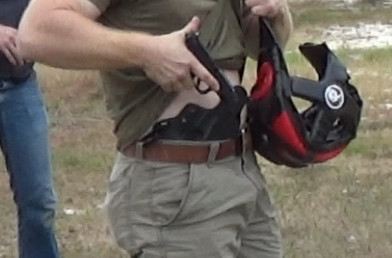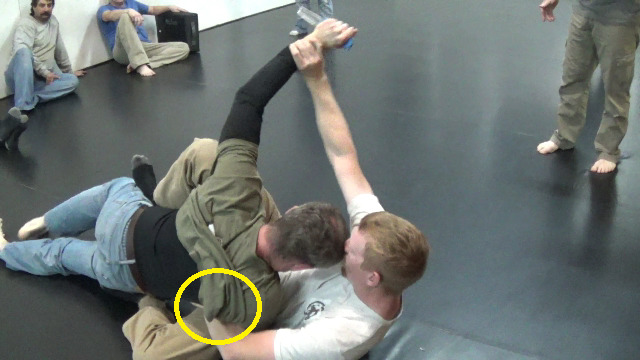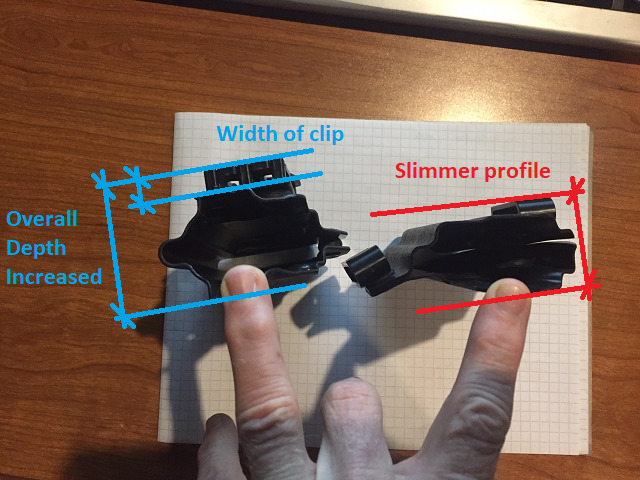Combatives Holsters:
We have conducted numerous classes on concealed carry utilizing everything from single-sided half shell holsters to outside the waistband leather models. While some look for functionally, others appearance, we look for the usability and practicality of the platform itself and whether it is a viable option to both train in on a regular basis and wear in everyday use. This article highlights some of the traits and characteristics I look for in a holster. To date I have not found one that meets all the requirements. Because this article is about characteristics, I am not going to be mentioning brand names but rather design traits to look for in a good design so you can make an educated decision and benefit from the dozens of models and hundreds of dollars we gone through in our training classes.
Feel:
The feel of the holster needs to allow for the user to operate in whatever conditions he/she needs, without becoming an impediment to them. For this reason, the ideal holster should be comfortable enough for the user to not just wear everyday but also allow for him/her to fight and train in under force on force conditions. If the holster is only comfortable standing at the range filming Instagram clips, then you won’t actually train in it (real training). If you don’t train in it, you’ll never achieve proficiency with the weapon it holds under real life conditions. So, although comfort is largely considered “unimportant” by the tacticool community of instaninjas it has a direct effect on your ability to achieve mastery with your weapon under realistic stresses.
When we talk about feel though, we’re talking about more than just comfort. Although comfort is an important factor, what I am referring to here is the ability to feel your weapon “on you” and “in place”. Weapons brought into a combatives scenario are free to be used by whomever can obtain them. This means that even if I don’t have a weapon on me, if I can obtain yours in a fight, its free for me to use.
Because of the dynamic stresses placed upon the weapon and holster during close-in combatives and grappling scenarios the user often losses feel for his weapon with various types of concealment holsters. This can happen for a variety of reasons that are simply too numerous to list. But one common reason is the holster has no retention ability on the weapon other than friction. Friction is often enough to hold a weapon in place as we run, climb and generally move about. However, when the body goes into unconventional positions trained on the ground or in close entanglement type scenarios, we sometimes lose some of that feel.
Actual Force on Force Training at 2018 Redbeard Combatives EDC class. Student in green is wearing a half shell design holster in appendix position.
A moment later the weapon has been removed without the student’s knowledge. 2018 Redbeard Combatives EDC class.
One way this can be mitigated is to simply have a holster design that allows for a solid “snap” when the weapon is inserted or drawn. Under stress this “pull” of the weapon followed by a sudden release is often enough to transmit feel to the user that his weapon has been removed. This snap also helps add an additional degree of retention to prevent the weapon from simply being released during high intensity combatives scenarios. Furthermore, it should allow for some degree of tension adjustment to allow the user to increase or decrease tension accordingly based on their build and carry position. Unfortunately, this design requirement tends to rule out single-side/half-shell holsters because of their lack of ability to provide this feature. Although among some of the most comfortable I’ve used they are less than desirable when it comes to feel and retention.
Holster Retention:
Now above we covered the ability of the holster itself to retain the weapon, and this is critical, but there is also another element of retention that is often overlooked except by those who actually put their equipment through the paces of full contact force on force training. Namely, that of the holster itself to remain on the user’s body and in position. I cannot tell you how many times I have seen the holster drawn right out of the students pants when he executes his draw.
Student attempts to draw and removes entire holster with weapon. 2018 Redbeard Combatives EDC class.
The holsters ability to remain in position is vitally important as the controls for the weapon are often covered by the holster itself and thus it cannot be utilized or easily rectified in this state. The solution I look for when looking for a holster is two solid retention clips (front and back). The placement of the clips is crucial specifically because it keeps the holster from “rocking”. One problem you have with a single clip design is the holster has the ability to rock (front to back). When this happens, the weapon can become difficult to retain. Without the ability to control the angle of the holster, the weapon can be removed fairly easily without the end user knowing it. Thus, it becomes important that the holster retain it’s designed access angle in relation to the users body to facilitate the weapon being drawn by its intended user and not his/her opponent.
Holster being pulled out of alignment (rocked) and accessed by opponent. 2018 Redbeard Combatives EDC class.
The holster’s the ability to remain in place is also directly affected by the design of the retaining clips themselves. There are numerous retaining belt clip designs on the market, some better than others. Some offer a full loop or belt through design. Others offer various different designs on the over belt clip on attachment.
Based on my experience the clip itself not only needs to be designed to be able to resist forces from all directions but it also needs to resist bending and twisting. This requires that the clips themselves be mounted to a structural point at, at least two points. A single point of attachment has a tendency to twist and allow the holster to shift under force and thus lose retention. Once again, this rules out half shell style holsters with a single screw attachment to the retaining clips. They are simply just too flexible and unreliable in their ability to maintain a positive connection to the belt of the user.

My preferred clip is a solid sturdy design with what I called a “retention ramp”. This ramp at the base of the clip forces the belt into the return hook. This in conjunction with rigid sturdy plastic as opposed to pliable or flexible material allows the design of the return hook to do its job in staying in place. That being said, a good closed-loop or through belt design is also suitable but is often limited to outside the waistband designs which can be a problem considering out next category.
Concealability:
Now this really shouldn’t even need to be annunciated but for some reason it does. The whole point of “concealed carry” is “concealed”. Its actually right in the term. Right before “carry”. For me outside the waistband is simply not an option unless I am working in a capacity that allows me to wear a jacket of some kind. I realize this may not be the case for everyone, but I wonder how many if they truly wore a holster that fit their attire instead of wearing attire that hid their holster would actually still wear outside the waistband.
When I look for concealability, I look for the smallest actual depth of holster (as measured by how far it protrudes from my body). From paddle holsters to half shell to expensive two-piece designs I’ve had the opportunity to put each to the test in force on force in real everyday clothes that you might wear to the grocery store or to the mall. Concealing a weapon under a business suit or sport coat is easy. No, the most common clothing worn by most people my age group is going to be jeans and a t-shirt or something of that nature. Therefore, since the idea is to not project an image that says, “today I am carrying and tomorrow I’m not” we want to maintain a consistent attire whether you are armed or not.
Having the smallest profile or projection from my body typically means that the newer larger style single clips are out. Although they are easy to put in place and remove, they fall short in several other areas mentioned above including preventing rocking, and now concealability. If your holster is 1.5” in depth and you add a 0.5” clip you now have a holster that protrudes from your body 2”. The same holster with an alternate mounting design could easily take back that extra 0.5” by utilizing a two-clip method in front and back vs a single clip.
Usability:
In the field of combatives the ultimate pressure test for all techniques is force on force training. We subject techniques and methodology to this requirement but I would venture to say that most people do not vet their EDC concealment holsters to the same requirement. The holster must be able to stand up to the rigors of force on force, if it can’t its probably not suitable for everyday use. Many of the expensive brand name holsters check a lot of boxes. But none that I have utilized have checked them all. I have spent hours and hours on the mat, in the gym and on the range experimenting, cutting, shaping and adding features to holsters to make them work. This article is an accumulation of many, but not all, of the problems we’ve encountered in training. To list them all would simply take more time then I have to write, and you have to read. Suffice it to say, training in your gear is not an option, it’s a requirement.
In the coming weeks I will be working with some holster manufacturers to implement many of the features discussed here. The goal being to provide a usable platform that will facilitate full contact training with no limitations and still provide a concealable, usable base for everyday carry.
Redbeard Combatives
Ben is the owner of Redbeard Combatives and has over 13 years of experience working with the U.S. Government and Private Security sectors, with a focus on training, physical security, and vulnerability assessments. He has deployed multiple times to austere locations including the Middle East and South America, as well as numerous at sea deployments providing training in vessel security aboard commercial ships transiting high-risk waters. Ben was the Assistant Team Leader on a US Department of State contract supporting humanitarian operations in Bolivia and Peru, conducting site security surveys and PSD operations in areas of civil unrest. He further provided physical security and personnel escort duties, working alongside U.S. military personnel at a forward operating base in Northern Afghanistan. Ben has provided courses of instruction in combatives to the Army’s 101st Airborne Division and members of the Hillsborough County Sheriff’s Office and is one of the lead self-defense and hand-to-hand combat instructors for a defense contractor in central Florida. Ben possess over 20 years of experience in the fields of civil and structural engineering design and holds a formal education in Intelligence Studies from American Military University, with advanced certifications in Counter Intelligence. He is a certified protection specialist, weapons instructor, Licensed Private Investigator and guest writer for numerous security publications.
*The views and opinions expressed on this website are solely those of the original authors and contributors. These views and opinions do not necessarily represent those of Spotter Up Magazine, the administrative staff, and/or any/all contributors to this site.







